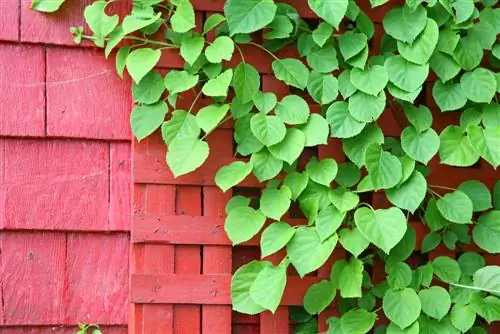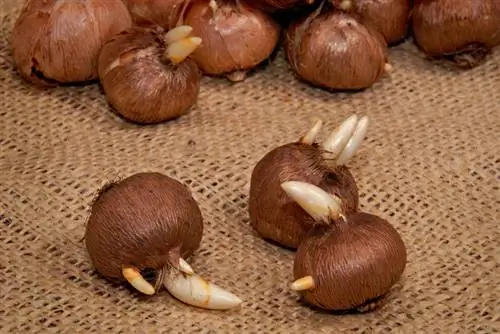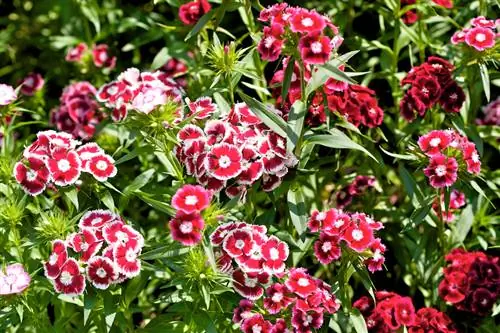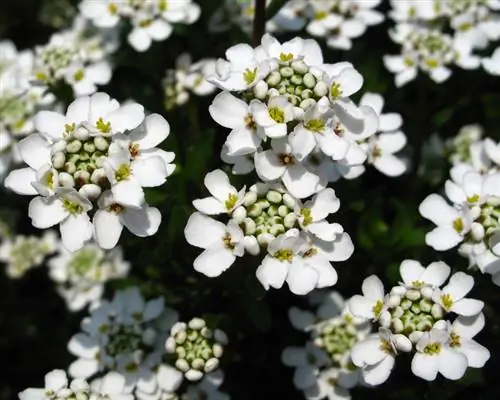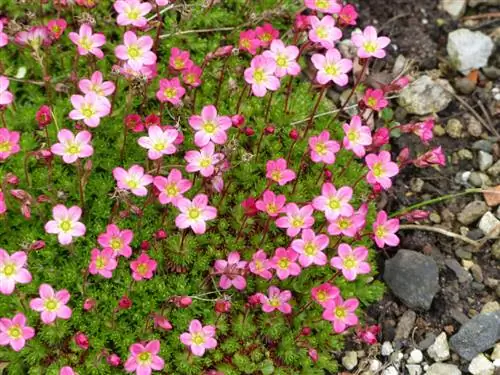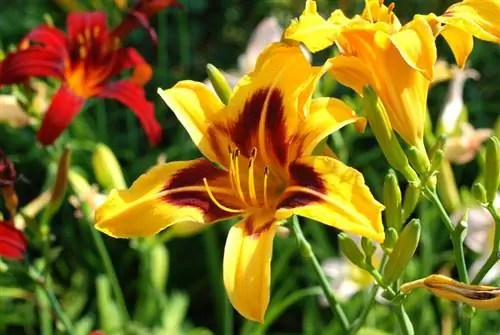- Author admin [email protected].
- Public 2023-12-25 17:45.
- Last modified 2025-01-23 11:21.
The climbing hydrangea (Hydrangea petiolaris) belongs to the hydrangea family (Hydrangeaceae) and is closely related to the garden hydrangea (Hydrangea macrophylla). Like these, climbing hydrangeas form large, umbrella-shaped inflorescences, but thanks to their adhesive roots they grow independently up to 15 meters high. The ornamental plant, which is often planted in gardens, can be used in a variety of ways and is considered extremely easy to care for.
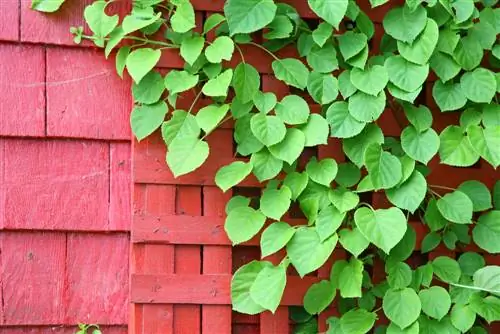
What is a climbing hydrangea?
The climbing hydrangea (Hydrangea petiolaris) is an easy-care climbing plant from the hydrangea family that can grow up to 15 meters high. It is suitable for greening house walls, fences or pergolas and has countless shiny green leaves as well as large, umbrella-shaped, creamy white flowers that appear between May and July.
Origin and distribution
Like many hydrangea plants, the climbing hydrangea comes from East Asia. In Korea, Japan and Taiwan the species is widespread both in gardens and in the vast forests. In Europe and America, the vigorous climbing plant is used as an ornamental plant, but due to its robustness it is now also being released into the wild.
Usage
As a classic climbing plant, Hydrangea petiolaris climbs house walls, fences, walls, old and dead trees, pergolas and other trellises. To do this, the plant uses its adhesive roots, with the help of which it climbs up independently and anchors itself to the ground. Trellises such as cords, hooks, etc. are only useful for freshly planted young plants so that they find the right path. If the plant cannot climb, it grows - depending on the variety - as a ground cover or a wide, hemispherical shrub up to two meters high.
Appearance and growth
On the side facing away from the light, the shoots of the climbing hydrangea form strong adhesive roots, which over time become woody and develop into thick branches. Older plants typically have very gnarled growth, and the reddish-brown bark on the thick wood also peels off. On walls, walls or trellises, climbing hydrangeas reach average heights of between six and seven meters, but in exceptional cases can also reach heights of up to 15 meters. In young plants, growth is comparatively slow at around 15 to 20 centimeters per year, but increases with age to annual growth of up to 40 centimeters - assuming optimal site conditions.
leaves
The dense foliage of climbing hydrangeas consists of numerous shiny green, rounded to egg-shaped leaves up to ten centimeters long. These are arranged opposite each other on long stems and, in most varieties, turn a wonderful yellow in autumn. However, some of the newer varieties no longer produce autumn colors, but remain green on the shoots until the next spring, at least in mild winters.
Bloom and flowering time
The large, umbrella-shaped flowers of climbing hydrangeas, which appear between May and July, are always creamy white. They exude a light, sweet scent that makes the plant irresistible to bees, bumblebees and butterflies. Due to their abundance of nectar, climbing hydrangeas are valuable insect food plants.
The flat umbrella panicles, up to 25 centimeters wide, consist largely of white, sterile show flowers. Only the inner petals - recognizable by the missing petals - are fertile.
If you want to enjoy the lush blooms of these plants, you need patience: climbing hydrangeas only bloom five to eight years after planting.
Fruits
The wild forms of the climbing hydrangea produce small, inconspicuous capsule fruits until autumn. However, the development of seed-containing fruits is not to be expected in cultivated forms.
Is climbing hydrangea poisonous?
Like all hydrangeas, the climbing hydrangea is considered slightly poisonous. All parts of the plant contain toxins such as glycosides (hydrocyanic acid), saponins as well as hydrangenol and hydrangin. When larger quantities are consumed, these cause mild symptoms of poisoning, such as dizziness and nausea. However, the leaves, flowers and other parts of the plant taste extremely bitter, so children are unlikely to be tempted to taste more of it. Rub a fresh leaf between your fingers and you will notice the slight smell of bitter almonds.
Furthermore, the ingredients of the climbing hydrangea can trigger a contact allergy in people who are sensitive to it, but this can be avoided by using gloves and other protective clothing (e.g. when pruning the plant).
Pets, on the other hand, are more problematic, because climbing hydrangeas are poisonous to cats, dogs, etc. and can cause serious symptoms of poisoning in them.read more
Which location is suitable?
Climbing hydrangeas feel most comfortable in bright, but not full sun and warm locations. Choose a partially shaded, lightly shaded or sunny spot, but it should not be directly shaded - if it is too dark for the plant, it will not produce flowers. A rather damp and cool location in the garden is also ideal.
Floor
Ideally, the potting soil is humus, fresh, permeable and slightly acidic. Climbing hydrangeas do not tolerate calcareous soil and are also very sensitive to heavy and compacted soil.
Planting climbing hydrangea correctly
Place the climbing hydrangea in a well-drained planting hole that is about twice as wide and deep as the plant's root ball. Loosen the side walls and the bottom of the hole with a digging fork to make it easier for the roots to grow. Mix the excavated material with mature compost, horn shavings and, if necessary, rhododendron soil. Attach the shoots of the young plant to a climbing aid to point it in the right direction. Especially on house walls, make sure to use a trellis and attach it about ten centimeters in front of the wall. The strong roots of the climbing hydrangea have the habit of actually digging into the plaster and finding support there. Of course, a climbing aid is only necessary if the plant is to be trained to climb. Otherwise it simply grows as a ground cover or wide bush.
Then cover the ground with a mulching material such as leaves, bark mulch, etc.to retain moisture in the soil. Ideally, before inserting, place the root ball in a bucket of lukewarm water so that the plant can soak up plenty of moisture.read more
What is the best time to plant?
The best time to plant a climbing hydrangea is early spring between March and April. However, the plants are usually available in containers and can generally be planted all year round. The only requirement is frost-free, mild weather. Avoid planting on hot, sunny days, otherwise the plants will quickly suffer from a lack of water and drought stress.
The correct planting distance
Climbing hydrangeas can grow up to five meters wide and require a lot of space. Therefore, plant them in individual positions and avoid underplanting - the resulting root pressure is not good for the plants. However, it is possible to associate with other climbing plants such as clematis.
Water climbing hydrangea
Basically, additional watering of planted climbing hydrangeas is not necessary because the plants take care of themselves via their widely branched root system. Only freshly planted specimens should be watered for a few weeks, as the roots themselves, which are not yet firmly anchored in the ground, cannot absorb enough moisture. Even during dry and hot mid-summer phases, watering must be carried out occasionally if necessary - for example because the plant leaves its leaves drooping.
Fertilize climbing hydrangeas properly
Climbing hydrangeas have quite high nutrient requirements and should therefore be supplied with organic fertilizer in spring. Compost, grass clippings or even bark mulch are particularly suitable for this.
If older plants don't really want to bloom, boosting fertilization with commercially available hydrangea or rhododendron fertilizer in the spring will help.
Cut climbing hydrangea correctly
As long as they have enough space to spread out, climbing hydrangeas do not need to be cut. However, the plants are quite tolerant of pruning and can easily be cut back to perennial wood. Young climbing hydrangeas branch more and then grow denser if they are shortened by a third immediately after planting.
Pruning measures should, if possible, be carried out before budding on a frost-free and mild day in February or March.
Propagate climbing hydrangea
Since fruits containing seeds are usually not produced, only vegetative propagation via cuttings, offshoots or cuttings is possible.
Cuttings
Cut head cuttings about ten to fifteen centimeters long in June, selecting shoots without flowers. Remove the lower leaves and dip the angled cut into a rooting powder (€8.00 on Amazon). Then plant the cuttings in small pots with growing substrate or directly in the desired location and keep them slightly moist. Rooting is successful when the first new shoots form.
offshoot
It is easier to propagate using offshoots, which, unlike cuttings, are not immediately separated from the mother plant. To do this, select young shoots growing close to the ground in May or June, pull them down, remove the leaves and lightly score them in one place. Plant these in the ground, only lightly covering the shoot area with soil. However, the branch must be weighed down with a stone or anchored with a wire so that it does not slip out of the planting site. Keep the cutting slightly moist and separate it from the mother plant the following spring as soon as it develops its own shoots.
Cuttings
Cuttings are cut in winter and stored in the vegetable compartment of the refrigerator or another cool place, wrapped in a damp cloth, until planting in spring. Stick the 15 to 20 centimeter long pieces of wood directly into the intended location and keep the soil there slightly moist.
Wintering
Climbing hydrangeas are sufficiently hardy and only require light winter protection in the first few years, for example by mulching with leaves or laying out spruce and fir branches.
How do I transplant correctly?
In principle, climbing hydrangeas can be transplanted as long as they have not been in their location for longer than five to six years. However, moving older, climbing specimens is almost impossible simply because of the strong trunk formation. Only shrubby plants can change location later.
The only important thing is that you do not transplant the plants unprepared. In the fall before the planned measure - which is best done in spring - dig a shallow trench around the main shoot, which you fill with compost soil. This forces the plant to form compact roots close to the trunk, making it easier for it to later grow in the new location.read more
pot culture
If the planter is large enough, the climbing hydrangea can also be cultivated in a pot. In such a plant, of course, the plant will not grow as large, but can still reach considerable dimensions. It is therefore rather unsuitable for keeping on the balcony, especially if it is a rented apartment. Many landlords prohibit the planting of climbing or climbing plants on the balcony, especially if they are self-climbing species. However, the climbing hydrangea is very suitable as a privacy screen on a terrace - for example planted in a raised bed box or similar and provided with a trellis.
Pests
Pests are rarely found on climbing hydrangeas. If so, they are usually sucking insects such as aphids. You often notice an infestation through short stature, stunted leaves, falling buds or a noticeably large number of ants around the infested plant. Prevent pest infestations through careful care, a suitable location and the settlement of beneficial insects in the garden. Install an insect hotel in a convenient location and ensure that birds, for example, have enough places to retreat and find food.
Diseases
Climbing hydrangeas are robust plants that are rarely affected by diseases. If the plant appears sick, errors in care or an unsuitable location are usually the cause. Chlorosis often occurs, in which the leaves turn yellow. The reasons are either a nutrient deficiency caused by incorrect or inadequate fertilization or an incorrect pH value. If this is more than 7, you should provide the climbing hydrangea with acidic rhododendron soil.
Mildew also occurs occasionally, with powdery mildew predominating in hot, dry weather and downy mildew in damp, cool summers. Spraying with field horsetail or garlic decoction helps against both fungal diseases, and severely affected leaves and shoots should also be removed.read more
Climbing hydrangea doesn't bloom, what to do?
If the climbing hydrangea doesn't bloom, there could be various reasons behind it:
- Nutrient deficiency: Provide the plant with compost or other organic fertilizers in spring.
- Lack of light: Although the climbing hydrangea is classified as shade-tolerant, it needs sufficient light for lush flowering.
- Pruning at the wrong time: Never cut climbing hydrangeas in autumn, as you will then remove the buds from the following year.
- Frost: Flower buds are formed the previous year and can freeze in harsh winters.
Tip
Wilting leaves are not only caused by a possible lack of water, but can also be due to waterlogging (and therefore rotting roots) or a location that is too sunny.
Species and varieties
These beautiful varieties of climbing hydrangea are suitable for home and hobby gardens:
- 'Semiola': wintergreen, copper-red shoots in spring, ideal as a ground cover
- 'Silver Lining': wintergreen, variegated foliage, suitable for keeping in containers
- 'Miranda': variegated foliage, particularly large flowers
- 'Cordifolia': Dwarf form, only grows to three meters high and 40 centimeters wide
The false or split hydrangea (Schizophragma hydrangeoides) is very similar to the climbing hydrangea, both in appearance and in its cultural and location requirements. The biggest difference between the closely related species is the growth rate: with an average height of two to six meters and a width of up to four meters, split hydrangeas remain smaller than the more vigorous climbing hydrangeas.

